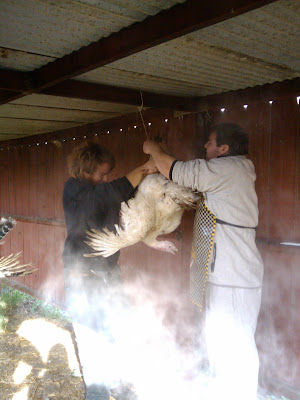Last Saturday there was a turkey slaughter at the farm. I was excited when Randy (farm manager) invited me to be a part of it. I had never done anything like it before... aside from being witness to many chicken slaughters at my grandma's homestead as a young child. I was excited yet somewhat grossed out for what was to come.
There were five turkeys that were slaughtered. Or was it four? I don't know. Either way, the turkeys that were slaughtered were huge (one ended up being 32 lbs after processing)! It was an 8AM slaughter and by the time I got to the farm, Farmer David was in the middle of transferring one of the turkeys from coop to the slaughtering station. The goats and lambs were making a lot of noise as we passed by turkey in hand... I think they sensed the ill-fated end to the turkey's life.
The slaughtering station was set up in three parts: slaughter--dunk&pluck--gutting and final processing. Slaughtering of poultry is usually done with a
cone where the poultry is put in head first and then their throats are slit to get most of their blood out. The cone works well because it contains the brunt of the thrashing that occurs after the poultry realizes... that, well, it's dying. Anyways, we didn't have a cone so we resorted to using a rope with an adjustable grip hitch knot. In lieu of the cone, someone had to hold the turkey in place when the thrashing occured. It is ideal for two people to do poultry slaughters so one can do the killing and the other handling. So, the slaughtering process went like this:
Hang the turkey by its feet and slit its throat quickly across the neck making sure to aim for the jugular vein and trachea. Completely sever the head after blood is drained.
 |
| Hanging turkey |
Then, transfer to second part of station - dunk the turkey's body in a large pot of boiling water (145 degrees F) for about 45 seconds.
 |
| Boiling water dunk |
Transfer to table and start plucking the feathers expeditiously. It is best to pluck the feathers as soon after it is hot from dunking because as it cools the skin constricts and makes it harder to pluck the feathers out. Also, I learned from my mistake that you have to be firm and careful with plucking because you can pluck the skin off with the feathers at times. Farmer David used pliers to remove the feathers on the wings as they were the hardest to pluck.
 |
| Plucking |
After plucking, gut it. Give it a horizontal cesarean cut on the stomach and cut around the anus. Then reach into the cavity and remove all organs. I was surprised to see some developing eggs in one of the turkey's guts. I was fascinated but also grossed out. Also, cut the legs off. Scion (David's daughter) fed the liver to one of the many cats roaming around the farm, which I thought was funny.
 |
| All done plucking, ready to be gutted. |
 |
| Farmer David gutting |
Finally, the turkey is given a final rinse and put in an ice bath before packing it up.
 |
| All done gutted. Huge turkey! 32 lbs! |
 |
| Ice-water bath |
It's funny to think that I was a part of this because I'm vegetarian. However, I believe the slaughtering of animals is just as vital a skill as growing vegetables on a farm. Industrial farming and modern food practices have made people so removed from the life and death cycle of their food, particularly meat. People who eat factory-farmed meat do not know the history of the animal they're eating, and thus have no meaningful connection to their food. (I turned to a vegetarian diet because of this; I didn't want to be part of a system that produced unsustainable and unethical meat.) Some don't want to even think about how their meat was slaughtered (or even are indifferent to how it was raised). There is a quote by
John Robbins that, I believe, sums up the meat industry's agenda:
Awareness is bad for the meat business. Conscience is bad for the meat business. Sensitivity to life is bad for the meat business. DENIAL, however, the meat business finds indispensable.
By being a part of this slaughtering process, I was going back to the roots of knowing where my food comes from. It was a learning experience that helped me put the whole farming experience in perspective and also gave me knowledge that I can use for future slaughters.









Comments
Post a Comment